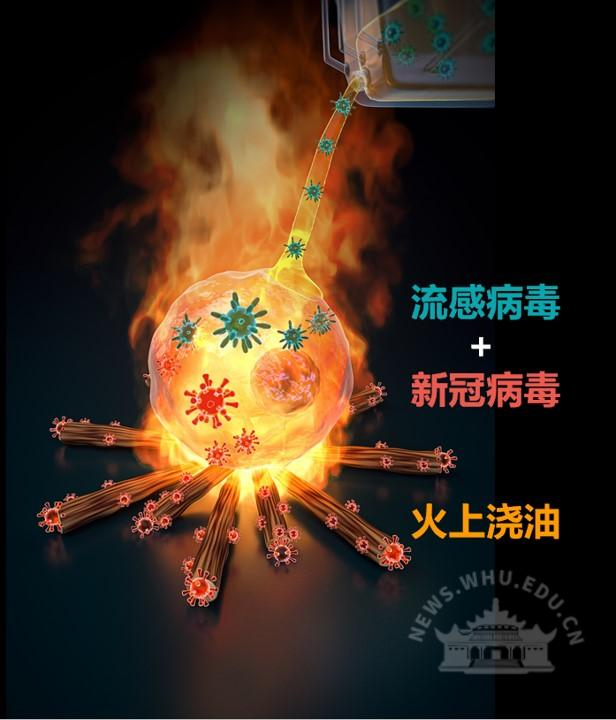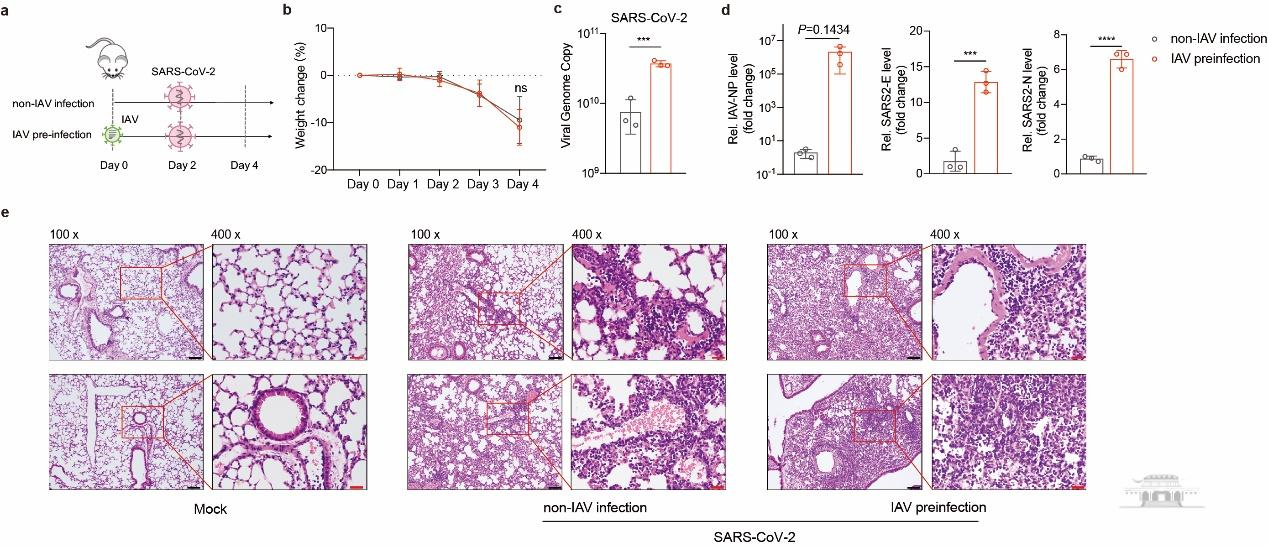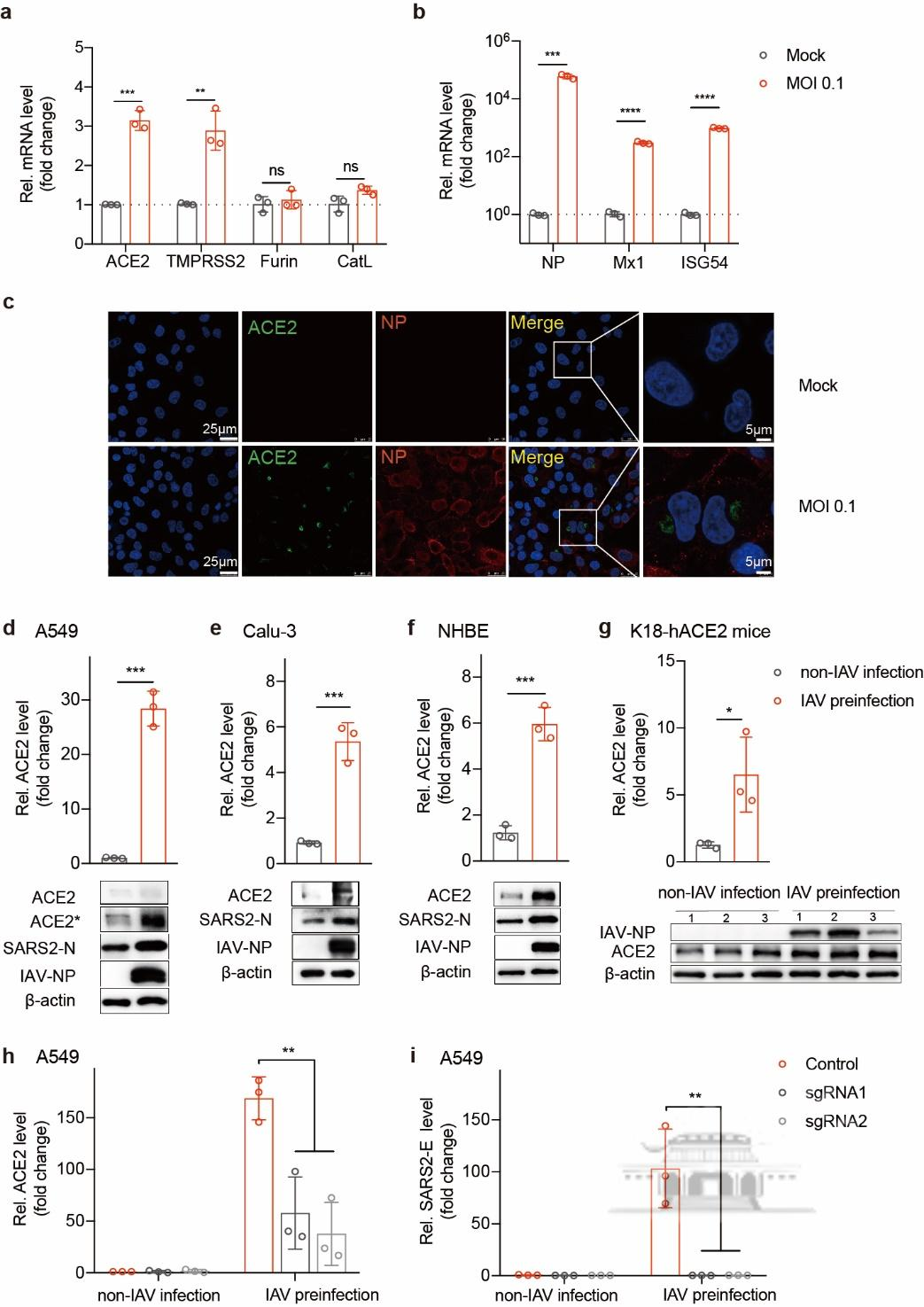The severe acute respiratory syndrome coronavirus-2 (SARS-CoV-2) and the seasonal influenza virus are both respiratory viruses. While the former has posed a great threat to human life and health, the latter is prevalent throughout the year. At present, the northern hemisphere is undergoing the flu season so that human beings are confronted with the dual threat of the new coronavirus and the influenza virus. Will the influenza virus and the new coronavirus co-infect individuals? What is the impact of influenza virus infection on new coronavirus infection? Will concurrent infection with the two viruses lead to more serious disease? There are no good scientific answers to these questions, which are of great concern to the field.
On February 18, the research group of Prof. Xu Ke and Prof. Lan Ke from the State Key Laboratory of Virology published a paper entitled Coinfection with Influenza A Virus Enhances SARS-CoV-2 Infectivity in Cell Research The paper reported for the first time that the influenza A virus (IAV) can significantly enhance SARS-CoV-2 virus infectivity and, by constructing a mouse model of influenza A virus and neocoronavirus co-infection, they found that co-infection with IAV and SARS-CoV-2 in mice results in more severe disease. The research team also conducted further studies on the molecular mechanism of IVA promoting the infection and pathogenicity of SARS-CoV-2. The results show that co-infection of the two viruses adds fuel to the fire (Fig. 1), which enhances the infectivity of SARS-CoV-2, and consequently causes more serious diseases. The research provides a scientific basis for further attention and prevention of co-infection with both viruses.
In the study, the research team first co-infected IAV (H1N1, H3N2, and influenza B) with pseudo-SARS-CoV-2 and live SARS-CoV-2 respectively. It was found that pre-infection with the influenza virus would significantly promote the invasion and replication of SARS-CoV-2, a phenomenon present in a variety of human respiratory tract cells and human lung tissue cells. As a result, the cells that were not infected with SARS-CoV-2 can be changed into completely susceptible ones, which indicates that co-infection of the two viruses may cause more cells and tissues in patients to be attacked by the virus (Fig. 2). In SARS-CoV-2 recipient human ACE2 transgenic mice, co-infection of IAV and SARS-CoV-2 results in more severe lung pathological damage and higher SARS-CoV-2 viral load (Fig. 3).

Fig.1 Co-infection of influenza virus and new coronavirus adds fuel to the fire
The research team then focused on ACE2, the key receptor of SARS-CoV-2 invasion. The results show that the ACE2 mRNA level was slightly increased (2-3 fold) due to post-IAV infection alone, but it was strongly up-regulated (about 20 fold) after IAV and SARS-CoV-2 co-infection (Fig. 4). This indicates that IAV infection is like an engine starter, which can aggravate SARS-CoV-2 infection by starting the expression of ACE2 and accelerating the subsequent expression process. The study also found that the regulative effect of IAV on ACE2 is not regulated by interferon, which indicates that the immune response of the body against IAV cannot protect individuals from the invasion of SARS-CoV-2. Therefore, it should not be deemed that immunity against other viruses can be obtained through the common flu. Fortunately, other common respiratory viruses such as HRSV, HPIV and HRV3 are not capable of promoting the infection of SARS-CoV-2. Therefore, dealing with the influenza virus is the top priority in co-infection prevention and control.
The study suggests that scientific monitoring and prevention should be carried out in response to the winter influenza and new coronavirus. At the same time, it is advocated that the public should be vaccinated against influenza and COVID-19 to reduce the risk of co-infection. The research also illustrates that the development of a new generation of broad-spectrum antiviral drugs for more than one virus is the pioneering trend in treating co-infection diseases.
The study is funded by the National Key R&D Program of China, Wuhan University New Coronavirus Research Project and Taikang Yicai Public Welfare Foundation, and is supported by Wuhan University Animal Biosafety Level 3 Laboratory. The co-first authors of the paper are Associate Researcher Bai Lei, post-doctoral scholar Dong Jiazhen, PhD students Zhao Yongliang and Liang Simeng, and senior experimentalist Guo Ming. Prof. Xu Ke and Prof. Lan Ke are the co-corresponding authors. Other members involved in the study are from the COVID-19 research group of the State Key Laboratory of Virology including Yan Huan, Chen Yu, Zhou Li and Dai Ming.

Fig.2 Pre-infection with influenza virus significantly promotes the infectivity of pseudo-SARS-CoV-2 and live SARS-CoV-2.

Fig.3 Co-infection of IAV and SARS-CoV-2 results in more severe lung pathological damage and higher SARS-CoV-2 viral load in ACE2 transgenic mice.

Fig.4 Influenza viruses aggravate SARS-CoV-2 infection by starting expression of ACE2.
Link to the paper:https://www.nature.com/articles/s41422-021-00473-1
Written by Zhu Ying
Rewritten by Shen Yutian
Edited by Zhu Tong